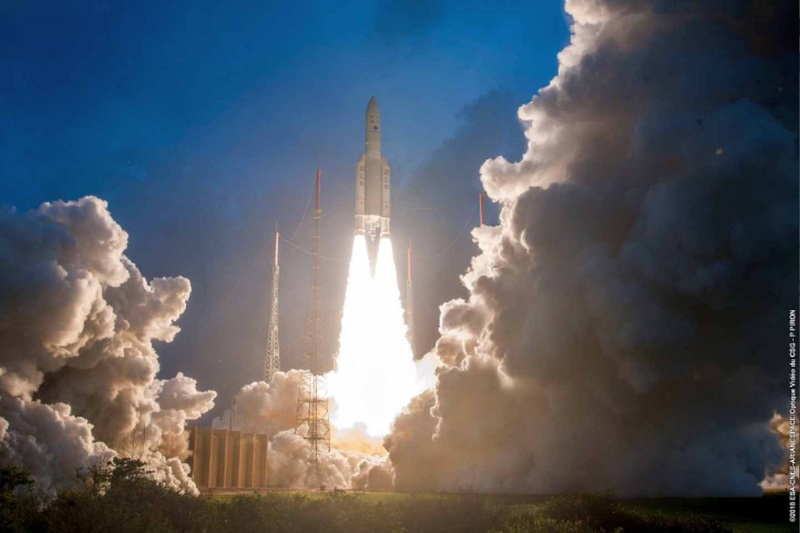- Sponsored -
ISRO successfully launches most-advanced high throughput communication satellite GSAT-11

The Indian Space Research Organisation (ISRO) on Wednesday early morning successfully launched its heaviest and most-advanced high throughput communication satellite GSAT-11 from the Spaceport in French Guiana. GSAT-11 is also known as “Big Bird”.
- Sponsored -
The launch vehicle Ariane 5 VA-246 lifted off from Kourou Launch Base, French Guiana at 02:07 am carrying India’s GSAT-11 and South Korea’s GEO-KOMPSAT-2A satellites, as scheduled. Ariane 5 is one of three launch vehicles operated by Arianespace along with Soyuz and Vega.
#VA246 passenger profile: the GSAT-11 advanced communications satellite, produced by @ISRO, will deliver multi-spot beam coverage over the Indian mainland and nearby islands – bringing significant advantages to the user community. It will operate from 74 deg. East. pic.twitter.com/AJNVeTbbhM
— Arianespace (@Arianespace) December 4, 2018
After a 30-min flight, GSAT-11 separated from the Ariane 5 upper stage in an elliptical Geosynchronous Transfer Orbit. The achieved orbit was very close to the intended one. The 5854-kg GSAT-11 will provide high data rate connectivity to users of Indian mainland and islands through 32 user beams in Ku-band and 8 hub beams in Ka-band.
Update #2#ISROMissions#GSAT11#Ariane5
Good Morning India! The heaviest, largest and most-advanced high throughput communication satellite of India, GSAT-11 was launched successfully from Kourou Launch Zone today onboard Ariane 5 VA246 launch vehicle. @PMOIndia@Arianespace pic.twitter.com/mxEdhar78w
— ISRO (@isro) December 5, 2018
ISRO Chairman Dr K Sivan said, “GSAT-11 will boost the broadband connectivity to rural and inaccessible Gram Panchayats in the country coming under the Bharat Net Project, which is part of Digital India Programme.”
Update #3#ISROMissions#Ariane5 VA-246 lifted off from Kourou Launch Base at 02:07 am (IST) carrying #GSAT11 and after a 30-min flight, GSAT-11 separated from upper stage in an elliptical Geosynchronous Transfer Orbit. Achieved orbit very close to the
intended one. pic.twitter.com/UjpgOhNK5X— ISRO (@isro) December 5, 2018
The Bharat Net Project aims to enhance the public welfare schemes like e-banking, e-health, e-governance among others.
He further said that GSAT-11 will act as a forerunner to all future high throughput communication satellites. “Today’s successful mission has boosted the confidence of the entire team,” Dr Sivan added.
Update #4#ISROMissions
Here's the video of #Ariane5 VA-246 lift off from Kourou Launch Base early today morning carrying India's #GSAT11 and South Korea’s GEO-KOMPSAT-2A satellites, as scheduled.
Video: @Arianespace pic.twitter.com/h0gjApbHHd
— ISRO (@isro) December 5, 2018
Post-separation, ISRO’s Master Control Facility at Hassan in Karnataka took over the command and control of GSAT-11 and found its health parameters normal. The scientists will undertake phase-wise orbit-raising manoeuvres in the days ahead to place the satellite in the Geostationary Orbit (36,000 km above the equator) using its on-board propulsion systems. GSAT-11 will be positioned at 74-degree east longitude in the geostationary orbit.
Update #5#ISROMissions
Here's the really massive fellow #GSAT11 all set to undertake communication duties for India. Scientists will now do phase-wise orbit-raising manoeuvres to place satellite in Geostationary Orbit (36,000 km above
equator) using onboard propulsion systems. pic.twitter.com/BxsGmwYNhY— ISRO (@isro) December 5, 2018
Subsequently, the two solar arrays and four antenna reflectors of GSAT-11 will be deployed in orbit. The satellite will be operational after the successful completion of all in-orbit tests. It is to be noted that in the last 21 days, ISRO successfully completed three satellite and two launch vehicle missions.
Also Read: ISRO successfully launches earth observation satellite and 30 other satellites
- Sponsored -
